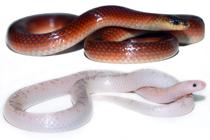1 Introduction
Wild albino and leucistic animals are usually rare, partially due to to their low survival rates, considering that specimens within these conditions may hatch stillborn, with malformations, and are easier to be detected by prey and predators than their normally colored counterparts, with negative impacts on their feeding and reproductive capabilities (Walter, 1938WALTER, H.E., 1938. Genetics: an introduction to the study of heredity. New York: Mac-Millan, pp. 422.; Oliveira, 2009OLIVEIRA, S.V., 2009. Albinismo parcial em Cutia Dasyprocta azarae (Lichtenstein, 1823) (Rodentia, Dasyproctidae), no sul do Brasil. Biotemas, vol. 22, pp. 243-246.; Krecsák, 2008KRECSÁK, L., 2008. Albinism and leucism among European Viperinae: a review. Russian Journal of Herpetology, vol. 15, no. 2, pp. 97-102.; Noronha et al., 2013NORONHA, J.C., BARROS, A.B., MIRANDA, R.M., ALMEIDA, E.J. and RODRIGUES, D.J., 2013. Record of leucism in Pseudoboa nigra (Serpentes: Dipsadidae) in southern Amazon, Brazil. Herpetology Notes, vol. 6, pp. 81-82.)
In this work, we follow the proposal of Van Grouw (2006)VAN GROUW, H., 2006. Not every white bird is an albino: sense and nonsense about colour aberrations in birds. Dutch Birding, vol. 28, no. 2, pp. 79-89., who considers leucism as a partial or total lack of eumelanin and phaeomelanin due to an inherited disorder in pigment transfer, which causes fail in melanin deposition within cells, although maintaining pigments in the back of the eyeball but not in the iris.
Here, we report the first record of leucism for Atractus reticulatus, a fossorial species of ground snake inhabiting the Pampas, Campos, southern Cerrado and transitional zones, occurring from Lowland to Lower Montane Semi-deciduous Forests between 0-1100 m high, from Southeastern and Southern Brazil, to Argentina and Uruguay (Passos et al., 2010PASSOS, P., FERNANDES, R., BERNILS, R.S. and MOURA-LEITE, J.D., 2010. Taxonomic revision of the Brazilian Atlantic Forest Atractus (Reptilia: Serpentes: Dipsadidae). Zootaxa, no. 2364, pp. 1-63.).
On May 12, 2016, the authors accidentally came across an adult female specimen of A. reticulatus with leucism, under construction debris in the Universidade Federal de Santa Maria campus, urban zone of Santa Maria (29º42’26.2” S, 53º51’52.3”W), Rio Grande do Sul, Brazil. The specimen was photographed, collected under permit (ICMBio 43658) and deposited in the herpetological collection of the Universidade Federal do Rio Grande (Rio Grande, Brazil) under the voucher CHFURG 4841.
The specimen characteristics (snout-vent length = 295 mm; tail length = 42 mm; mass = 14.94 g; ventral scales = 151; subcaudal scales = 33) matches the diagnosis of Passos et al. (2010)PASSOS, P., FERNANDES, R., BERNILS, R.S. and MOURA-LEITE, J.D., 2010. Taxonomic revision of the Brazilian Atlantic Forest Atractus (Reptilia: Serpentes: Dipsadidae). Zootaxa, no. 2364, pp. 1-63.. The specimen presents a uniform dorsal and ventral white coloration with few dorsal scales margined by vestigial orange or black pigmentation, and uniform black eye with red iris (Figure 1).
Normal (Top, Unvouchered) and leucistic (Bottom, CHFURG 4841) specimens ofAtractus reticulatus.
This is the first record of leucism in the wild for genus Atractus. Our finding seems to corroborate recent studies suggesting that chromatic anomalies might be more common in species of crepuscular, nocturnal, cryptozoic or fossorial habits, with reduced impact for predation by visually-oriented predators (e.g. Sazima and Di-Bernardo, 1991SAZIMA, I. and DI-BERNARDO, M., 1991. Albinismo em serpentes neotropicais.Memorias do Instituto Butantan, vol. 53, no. 2, pp. 167-173.; Esqueda et al., 2005ESQUEDA, L.F., LA MARCA, E. and SORIANO, P., 2005. Partial albinism in a Venezuelan specimen of false coral snake, (Linnaeus, 1758). Oxyrhopus petola petolaHerpetotropicos: Tropical Amphibians & Reptiles, vol. 2, no. 2, pp. 114-115.; Abegg et al., 2014ABEGG, A.D., MARIO-DA-ROSA, C., CAVALHEIRO, C.P., ORTIZ, F.R. and MALTA-BORGES, L., 2014. Partial albinism in (Boulenger, 1885) (Serpentes: Dipsadidae) in Rio Grande do Sul state, Brazil. Sibynomorphus ventrimaculatusHerpetology Notes, vol. 7, pp. 475-476., 2015ABEGG, A.D., ENTIAUSPE-NETO, O.M. and LEMA, T., 2015. First record of albinism in the Elapomorphini tribe (Serpentes: Dipsadidae). Herpetology Notes, vol. 8, pp. 503-505.). Leucism seems to be a very rare condition in A. reticulatus, considering that even being an abundant species in inland portions of Rio Grande do Sul state, and yet, no other similar specimens were reported or encountered in herpetological collections.
Acknowledgements
We thank Ray Morgan for kindly providing an English revision of the manuscript.
-
(With 1 figure)
References
- ABEGG, A.D., ENTIAUSPE-NETO, O.M. and LEMA, T., 2015. First record of albinism in the Elapomorphini tribe (Serpentes: Dipsadidae). Herpetology Notes, vol. 8, pp. 503-505.
- ABEGG, A.D., MARIO-DA-ROSA, C., CAVALHEIRO, C.P., ORTIZ, F.R. and MALTA-BORGES, L., 2014. Partial albinism in (Boulenger, 1885) (Serpentes: Dipsadidae) in Rio Grande do Sul state, Brazil. Sibynomorphus ventrimaculatusHerpetology Notes, vol. 7, pp. 475-476.
- ESQUEDA, L.F., LA MARCA, E. and SORIANO, P., 2005. Partial albinism in a Venezuelan specimen of false coral snake, (Linnaeus, 1758). Oxyrhopus petola petolaHerpetotropicos: Tropical Amphibians & Reptiles, vol. 2, no. 2, pp. 114-115.
- KRECSÁK, L., 2008. Albinism and leucism among European Viperinae: a review. Russian Journal of Herpetology, vol. 15, no. 2, pp. 97-102.
- NORONHA, J.C., BARROS, A.B., MIRANDA, R.M., ALMEIDA, E.J. and RODRIGUES, D.J., 2013. Record of leucism in Pseudoboa nigra (Serpentes: Dipsadidae) in southern Amazon, Brazil. Herpetology Notes, vol. 6, pp. 81-82.
- OLIVEIRA, S.V., 2009. Albinismo parcial em Cutia Dasyprocta azarae (Lichtenstein, 1823) (Rodentia, Dasyproctidae), no sul do Brasil. Biotemas, vol. 22, pp. 243-246.
- PASSOS, P., FERNANDES, R., BERNILS, R.S. and MOURA-LEITE, J.D., 2010. Taxonomic revision of the Brazilian Atlantic Forest Atractus (Reptilia: Serpentes: Dipsadidae). Zootaxa, no. 2364, pp. 1-63.
- SAZIMA, I. and DI-BERNARDO, M., 1991. Albinismo em serpentes neotropicais.Memorias do Instituto Butantan, vol. 53, no. 2, pp. 167-173.
- VAN GROUW, H., 2006. Not every white bird is an albino: sense and nonsense about colour aberrations in birds. Dutch Birding, vol. 28, no. 2, pp. 79-89.
- WALTER, H.E., 1938. Genetics: an introduction to the study of heredity. New York: Mac-Millan, pp. 422.
Publication Dates
-
Publication in this collection
25 May 2017 -
Date of issue
Feb 2018
History
-
Received
15 June 2016 -
Accepted
01 Sept 2016



